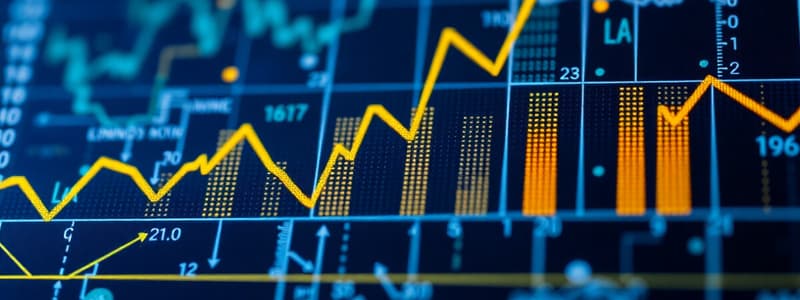Podcast
Questions and Answers
Which of the following best describes the primary goal of econometrics?
Which of the following best describes the primary goal of econometrics?
- To predict future economic outcomes using solely theoretical assumptions.
- To formulate economic theories based on qualitative analysis.
- To provide empirical evidence to support or refute economic theories. (correct)
- To create mathematical models of economic systems without empirical testing.
What is the purpose of regression analysis in econometrics?
What is the purpose of regression analysis in econometrics?
- To analyze the behavior of economic units over time using both time series and cross-sectional data.
- To estimate the relationship between a dependent variable and one or more independent variables. (correct)
- To summarize and describe the main features of a dataset.
- To analyze data collected over time to identify trends.
Which of the following econometric methods is most suitable for analyzing the impact of a new government policy on unemployment rates over a 10-year period?
Which of the following econometric methods is most suitable for analyzing the impact of a new government policy on unemployment rates over a 10-year period?
- Time series analysis. (correct)
- Spatial econometrics.
- Cross-sectional regression.
- Descriptive statistics.
What is the primary purpose of using mathematical models in economics?
What is the primary purpose of using mathematical models in economics?
In mathematical economics, what is the role of optimization theory?
In mathematical economics, what is the role of optimization theory?
Which mathematical tool is commonly used to analyze rates of change and optimization problems in economics?
Which mathematical tool is commonly used to analyze rates of change and optimization problems in economics?
What does descriptive statistics primarily aim to do?
What does descriptive statistics primarily aim to do?
Which of the following is an example of inferential statistics?
Which of the following is an example of inferential statistics?
In hypothesis testing, what does the null hypothesis typically represent?
In hypothesis testing, what does the null hypothesis typically represent?
Which of the following economic concepts is most closely associated with the need for societies to make choices about how to allocate limited resources?
Which of the following economic concepts is most closely associated with the need for societies to make choices about how to allocate limited resources?
What is the 'opportunity cost' of a decision?
What is the 'opportunity cost' of a decision?
What is the key difference between microeconomics and macroeconomics?
What is the key difference between microeconomics and macroeconomics?
What is the main difference between positive and normative economics?
What is the main difference between positive and normative economics?
Which of the following is a common problem encountered in econometric analysis due to high correlation among independent variables?
Which of the following is a common problem encountered in econometric analysis due to high correlation among independent variables?
What does the concept of 'market equilibrium' primarily refer to?
What does the concept of 'market equilibrium' primarily refer to?
What is the variance a measure of?
What is the variance a measure of?
How does game theory contribute to economic analysis?
How does game theory contribute to economic analysis?
What is the purpose of confidence intervals in statistics?
What is the purpose of confidence intervals in statistics?
If you are attempting to model consumer behavior, which mathematical technique would be most applicable to determine how a consumer maximizes their satisfaction given a budget constraint?
If you are attempting to model consumer behavior, which mathematical technique would be most applicable to determine how a consumer maximizes their satisfaction given a budget constraint?
Which of the following is NOT typically considered an econometric software package?
Which of the following is NOT typically considered an econometric software package?
Flashcards
What is Economics?
What is Economics?
The study of production, distribution, and consumption of goods and services.
What is Microeconomics?
What is Microeconomics?
Focuses on individual economic agents like households and firms.
What is Macroeconomics?
What is Macroeconomics?
Examines the economy as a whole, including inflation and unemployment.
What is Opportunity Cost?
What is Opportunity Cost?
Signup and view all the flashcards
What is Econometrics?
What is Econometrics?
Signup and view all the flashcards
What is Regression Analysis?
What is Regression Analysis?
Signup and view all the flashcards
What is Time Series Analysis?
What is Time Series Analysis?
Signup and view all the flashcards
What is Panel Data Analysis?
What is Panel Data Analysis?
Signup and view all the flashcards
What is Mathematical Economics?
What is Mathematical Economics?
Signup and view all the flashcards
What is Calculus in Economics?
What is Calculus in Economics?
Signup and view all the flashcards
What is Game Theory?
What is Game Theory?
Signup and view all the flashcards
What is Statistics?
What is Statistics?
Signup and view all the flashcards
What are Descriptive Statistics?
What are Descriptive Statistics?
Signup and view all the flashcards
What are Inferential Statistics?
What are Inferential Statistics?
Signup and view all the flashcards
What is Hypothesis Testing?
What is Hypothesis Testing?
Signup and view all the flashcards
What are Confidence Intervals?
What are Confidence Intervals?
Signup and view all the flashcards
What is Probability Theory?
What is Probability Theory?
Signup and view all the flashcards
What are Random Variables?
What are Random Variables?
Signup and view all the flashcards
What are Probability Distributions?
What are Probability Distributions?
Signup and view all the flashcards
What are Expected Values?
What are Expected Values?
Signup and view all the flashcards
Study Notes
- Economics is a social science focused on the production, distribution, and consumption of goods and services.
- Economics analyzes resource allocation choices made by individuals, businesses, governments, and societies to fulfill wants and needs.
- Microeconomics studies individual economic agents like households, firms, and markets.
- Macroeconomics studies the economy as a whole, covering inflation, unemployment, and economic growth.
- Key economic concepts: scarcity, opportunity cost, supply and demand, elasticity, and market equilibrium.
- Economic models are simplified representations of reality that are used to analyze and predict economic phenomena.
- Positive economics describes economic phenomena as they are; normative economics involves value judgments about what the economy should be.
Econometrics
- Econometrics applies statistical methods to economic data, providing empirical support for economic models and theories.
- Econometrics uses statistical techniques to estimate economic relationships, test economic theories, and forecast economic outcomes.
- Econometric methods include regression analysis, time series analysis, and panel data analysis.
- Regression analysis estimates the relationship between a dependent variable and one or more independent variables.
- Time series analysis analyzes data collected over time to identify patterns and trends.
- Panel data analysis combines time series and cross-sectional data to analyze the behavior of economic units over time.
- Key econometric concepts include hypothesis testing, statistical significance, and model specification.
- Common econometric problems include multicollinearity, heteroscedasticity, and autocorrelation.
- Econometric software packages such as Stata, EViews, and R are used to perform econometric analysis.
Mathematical Economics
- Mathematical economics uses mathematical methods to represent and analyze economic theories and models.
- Mathematical economics provides a formal framework for expressing economic ideas and deriving testable predictions.
- Mathematical tools used in economics include calculus, linear algebra, optimization theory, and game theory.
- Calculus analyzes rates of change and optimization problems in economics.
- Linear algebra solves systems of equations and analyzes economic models with multiple variables.
- Optimization theory finds the best possible outcome for economic agents given their constraints.
- Game theory analyzes strategic interactions between economic agents.
- Mathematical economics studies topics like consumer behavior, production theory, market equilibrium, and macroeconomic dynamics.
- Common mathematical models in economics include utility maximization, profit maximization, and general equilibrium models.
Statistics
- Statistics is the science of collecting, analyzing, and interpreting data.
- Statistics provides tools and methods for quantifying uncertainty and making inferences from data.
- Descriptive statistics summarize and describe the main features of a dataset.
- Measures of central tendency include the mean, median, and mode.
- Measures of dispersion include the variance, standard deviation, and range.
- Inferential statistics make generalizations about a population based on a sample of data.
- Hypothesis testing determines whether there is enough evidence to reject a null hypothesis.
- Confidence intervals estimate the range of values that a population parameter is likely to fall within.
- Probability theory provides the foundation for statistical inference.
- Key concepts in probability theory include random variables, probability distributions, and expected values.
- Statistical methods are used in diverse fields, including economics, finance, marketing, and healthcare.
Studying That Suits You
Use AI to generate personalized quizzes and flashcards to suit your learning preferences.



